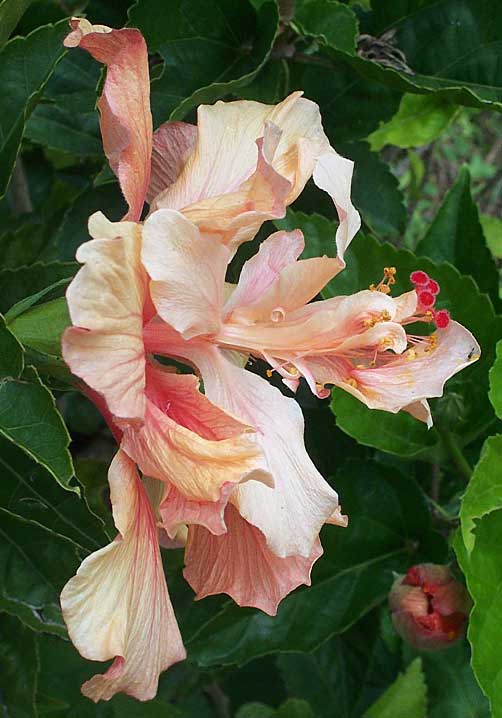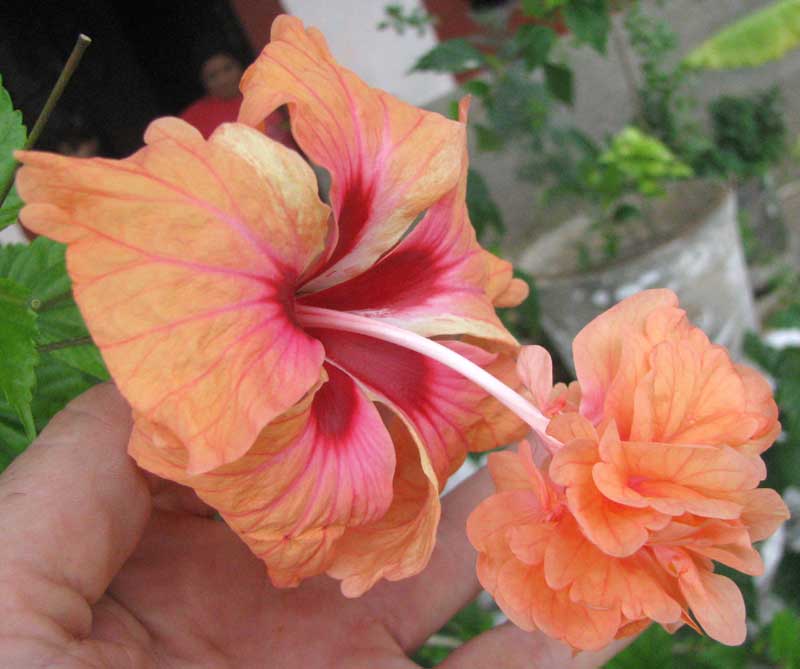Excerpts from Jim Conrad's
Naturalist Newsletter
from the October 13, 2008 Newsletter written in Yokdzonot, Yucatán, México
HIBISCUS FLOWERS
With more annual rainfall the air here is softer and the landscape lusher. Even the most desperate looking huts usually are surrounded by beautiful assemblages of flowering plants. One of the prettiest blossoms is shown below:

That's the Chinese Hibiscus, HIBISCUS ROSA-SINENSIS, a much branching, ten-ft-high shrub in full flower here, its red blossoms shockingly vivid against dark green, leafy backgrounds. The species comes from tropical Eastern Asia but now is planted in the tropics worldwide.
In the picture, the long, slender thing dangling from the crimson corolla is the "staminal column," stamens being a flower's male parts. The many items looking like pink matchsticks with yellow heads are the stamens, the yellow, spherical items being the pollen- holding anthers and the pink stems the filaments. Emerging from the cylindrical staminal column at the very bottom are five style branches, each terminated by a globular stigma. Stigmas are where pollen grains germinate and send their male-sex-germ pollen tube, root-like, down through the slender style inside the staminal column, to the ovary deep at the flower's bottom.
from the October 29, 2007 Newsletter issued from Mexico's Southernmost State, CHIAPAS
INÉS'S MESSED-UP ROSE-OF-CHINA
Take a look at a flower on one of Inés's Rose-of-Chinas below.

Rose-of-Chinas aren't roses at all, but rather Hibiscuses, specifically HIBISCUS ROSA-SINENSIS, and the species probably did originate in China. They're such gorgeous plants that now they're grown worldwide in hot climates, and have been bred into many horticultural forms.
In fact, the blossom in the picture is from a plant whose genes plant breeders have tinkered with in order to get a flashier blossom than those of standard Rose- of-Chinas. Flowers of normal Rose-of-Chinas have their male stamens mounted on a cylinder, or column, around the female style, as shown in the top, left photo at www.backyardnature.net/fl_hibsc.htm.
What's happened with Inés's plant is that genetic manipulation has caused stamens on the blossom's staminal column to form petals instead of stamens. In the picture, notice how on the column arising in the flower's center and pointing to the right stamens are mingled with petals, and notice that some of those petals have brownish, lumpy areas along one of their sides. Those brownish, lumpy spots are "almost- stamens." One side of the petal is pure petal but the other side is almost a stamen.
It turns out that, because early in the evolutionary history of flowering plants petals arose from primitive stamens, much of the genetic information that makes a petal is the very same information used to create a stamen. Thus plant breeders just needed to fiddle with genes producing stamens on the normal Rose-of-China's staminal tube and, presto, a blossom with more flower petals than normal resulted.
Plant breeders use this trick a lot, probably most successfully among the roses. At the bottom of my page at www.backyardnature.net/fl_roses.htm you can see a spectacular instance of a rose stamen with one side of its anther normal, but the other side clearly trying to be a petal!
I don't like "double-flowered" varieties of anything. Nature spent millions of years evolving blossoms to be the unique things they are, and now humans are re-evolving them just for bigger, gaudier flowers. Now not only hibiscuses but also buttercups, camellias and other completely unrelated plants produce similarly bright and colorful, but monotonously same-looking blossoms.
from the March 11, 2012 Newsletter issued from Hacienda Chichen Resort beside Chichén Itzá Ruins, central Yucatán, MÉXICO
A FLOWER FROM LIBRE UNION
Last Sunday in the nearby town of Libre Union we came upon the following flower, all of whose stamens appear to have been converted to petals:
